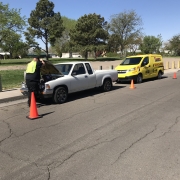Tips: Stay Safe as You Wait for Emergency Roadside Assistance
Emergency Roadside Assistance
We try to avoid it, but over 95 percent of drivers experience a roadside breakdown, according to car insurance companies. A dead battery or mis-fueling are two leading causes.
Help is a mobile phone call away, but safety is still important while you wait for emergency roadside assistance. Here are some handy roadside safety tips to get you through an emergency breakdown.
Keep Roadside Emergency Items in Your Vehicle
Half the safety battle is preparing for an emergency breakdown before you start driving. Emergency items include:
- First aid kits
- Drinking water
- Non-perishable food
- Cell phone chargers
- Road flares and emergency markers
- Reflective vest
You’ll also need jumper cables, a spare tire, and other tools.
Good roadside assistance services may provide a spare tire or mobile battery replacement if you need it. But if they don’t, you could end up stuck longer.
Exit the Vehicle Carefully
The safest option is to park your car completely off the road (if you can) and remain inside until emergency roadside assistance arrives.
If you must exit the vehicle, always exit opposite the road and wear a reflective vest. Do not remain in the incoming traffic path for any reason, especially if it’s dark or on the interstate.
Use Hazard Lights and Warning Markers
Other drivers must know your car is stopped before they are upon it. This is very important for cars traveling +60mph that can’t react to a roadside breakdown at the last second.
Keep your hazard lights on, if you can. A completely dead battery may not power hazard lights, and running hazards for a few hours can drain the battery.
Road flares and roadside emergency markers will help other motorists avoid collisions if hazards aren’t an option.
Call Emergency Roadside Assistance
It’s tempting to call family or friends first, but emergency roadside assistance should be the phone call priority.
Roadside assistance services can generally respond more quickly, find you much faster, and they are already prepared for most common car issues.
Stay Vigilant During the Roadside Breakdown
Other motorists may pull over to assist you with the emergency breakdown. If you let them help, it’s a risk to their safety and yours.
Most people are genuinely helpful, but the safest choice is to remain inside, with your doors locked. You can crack your window slightly to exchange information.
Inform other motorists that emergency roadside assistance and highway patrol has your location and is on the way. This will let the good samaritans know you’re safe, and also deter would-be criminals.
Stay Hydrated, Warm, or Cool
Roadside breakdown planning should factor in the people traveling with you, and the time it would take emergency roadside assistance to reach your vehicle. Avoiding dehydration is crucial for certain situations:
- High heat and dry climates
- Very cold climates
- Traveling with babies, toddlers, or young children
- Traveling with senior citizens
- Areas far from amenities
- Driving after hiking or other strenuous activities
One lone water bottle won’t be enough preparation. Experts recommend drinking around half a gallon a day on average.
You may also need items like portable battery fans or blankets in climates with extreme summer and winter temperatures.
Don’t Let a Roadside Emergency Break You Down
An emergency breakdown is stressful and scary, but there are steps to stay safe. Preparation and situational awareness will save the day.
Emergency roadside assistance is also your savior. If you need a fast and comprehensive response, contact us at Dugger’s Road Service for 24-hour roadside assistance services.
4 Common Causes Of Car Breakdowns
Tire Change Service
What to Do If Your Car Breaks Down on the Highway

 2016
2016
